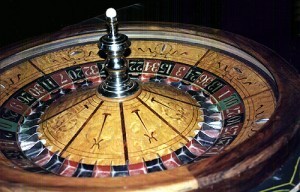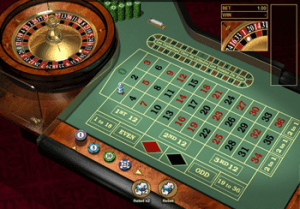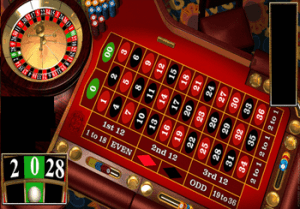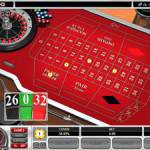Roulette is by far and away the most popular wheel game played in casinos today, however even the keenest players have probably given very little thought to one of the most important aspects of the game – the roulette wheel itself.
Roulette wheels have been around for hundreds of years and, while modern wheels may be more consistent and reliable than their older counterparts, the basics of the way they function and operate are the same as they were in 18th Century France.
History of the Roulette Wheel

While roulette wheels have always contained numbered pockets that represented the numbers players could bet on during a game, the exact layout of the wheel has changed several times throughout history.
The first wheels that definitely used something similar to modern rules were found in Paris in 1796. The early version of the roulette wheel was similar to the modern American wheel and featured 36 numbers along with a zero and double zero. Early on, one of the zeroes was colored red, while the other was colored black. This was to make it clear that these spots would not win on even money bets. The zeroes were changed to green, a change that has remained to this day.
In 1843 a casino in Hamburg decided they wanted to attract players by offering a better roulette game than their competitors. They realized that even if they made changes that favored the player, roulette could still have enough of an edge for the casino to make the game profitable. This lead to the roulette table adopting a single zero wheel – a game that remains known as European roulette today.
Meanwhile, roulette was also gaining popularity in the United States, albeit with a rather different style. The roulette wheel in America in the 19th century featured only 28 numbers, as well as a zero, a double zero, and the iconic American eagle symbol (which essentially acted as a third zero). This may be the version of roulette with the highest house edge in history, as single number bets paid 27-1 and there were 31 spots on the wheel. The house held a 9.68% advantage over players! Not surprisingly, this wheel would eventually fall out of fashion and the eagle was removed from the roulette wheel.
Eventually, the traditional French wheel – the one with two zeroes – made its way through New Orleans and into the United States, becoming the de facto standard there. Meanwhile, the German wheel became the one used in European casinos, leading to the situation today where both American roulette and European roulette have been allowed to flourish in different parts of the world. Both of these wheels now feature 36 numbered pockets divided evenly between red and black colors, while the zeroes – one in European roulette, and two in American roulette – are colored green.
Modern technology and the broadening of player tastes means we can expect to see some different styles of roulette wheels, be it online, digital or in a live casino. Recently Al Moe wrote about the ç, which features two sets of numbers on different rings, yet on the same wheel. It offers a whole world of new and exciting odds. We can expect to see more of these innovative designs in the future.
Roulette Wheel and Table Layouts
Although it may be difficult to discern a pattern when you look at the numbers on a roulette table, it should be noted that they are not randomly distributed. Instead, a specific order of numbers is used at most casinos, beginning with the single zero and moving from there. However, the pattern is (necessarily) different between the single-zero and double-zero wheels.
In European single-zero games, the pattern of numbers is especially important, as certain bets (known as French bets) are commonly made that cover portions of the wheel. For instance, Voisins du zéro (neighbors of zero) covers the 17 numbers that surround the zero on the wheel, including the zero itself. Other French bets cover thirds of the wheel, such as the 12 numbers between 27 and 33 on the layout (including those two numbers).
The colors associated with each number are not random either and follow a fairly simply pattern. For the number ranges 1-10 and 19-28, odd numbers are red, while even numbers are black. Conversely, in the number ranges 11-18 and 29-36, odd numbers are black and even numbers are red.
European Roulette

European roulette is the form of roulette most commonly encountered in casinos in Asia, Europe and Africa. Online casinos do tend to offer both American and European roulette; however players who have the choice should virtually always choose an European roulette table as it offers far better odds to the players.
All European roulette games feature a single zero wheel, without the double-zero (00) found on American wheels. This is immediately beneficial for the player, as it lowers the house edge on most bets to just 2.7%.
However, true European roulette games also feature what is known as the “en prison” rule. Under this rule, players at the roulette table will have a chance to recover their bets should they make a wager on any of the even money bets (such as odd/even or red/black) and see the ball land on the zero.
What exactly happens to bets in this case can vary depending on the rules at your casino. In some casinos, the player will immediately get half of their bet back, cutting the house edge to 1.35%. However, the player may also choose to keep the bet “imprisoned”, hoping to win on the next spin.
Should the next spin result in a win for that bet the player will receive their entire bet back, while a loss will result in the loss of the entire bet. If the ball should land on zero again, the bet may be lost, held over again for the next spin, or become “double-imprisoned” – depending on the rules at that casino. From the player’s perspective, however, simply surrendering half of their bet at the start is a slightly better bet than going through the imprisonment process.
European roulette games are also known for the “French bets” that are sometimes associated with them. On some European roulette table layouts you will see added betting areas that allow you to bet on specific regions of the wheel. These bets are particularly popular in high-stakes games.
American Roulette

American roulette is the version of the game that is most often found in the Americas, particularly in the United States, Canada, the Caribbean, and South American casinos. In this version, the roulette wheel traditionally contains 38 numbers. It has the numbers 1-36, as well as both a zero (0) and double zero (00).
With an American roulette table, nearly all bets pay out at odds that would be fair if it were not for the presence of the two zeroes. For instance, a single number bet pays 35-1 with the house edge being added by the zero and double zero spaces. Thus, on almost all bets, the house edge is 5.26%.
In some casinos that spread American roulette, single-zero wheels are also available at higher limits. These games carry a house edge of 2.7%, similar to most European roulette bets.
In Atlantic City casinos American roulette table rules are followed (including double-zero wheels), but players receive half of their money back if they have made an even money bet such as red/black and the ball lands on a zero. This changes the house edge on only those bets to 2.63%.
French Roulette Online

We should also take a moment to talk about a special version of European roulette that is known as French roulette. In almost all ways related to the rules of the game, French roulette is identical to European roulette. However, there are a couple of visual differences you’ll find while playing.
On a true French roulette table the table layout will typically have all of the numbers labelled in red. The red/black bet still exists, as the wheel itself still has half of the pocket numbers colored in black. This gives the table itself a very striking and elegant design.
A French casino roulette table layout will also typically include the “French bets” – wagers that can be made in order to cover portions of the roulette wheel. These bets include the popular Voisins du Zero wager (Neighbors of Zero), which covers all of the numbers closest to the zero on the wheel.
French roulette will also use the standard en prison rule. In most French casinos (and many online French roulette games) the rule is referred to specifically as la partage, which refers to the version in which the player immediately receives half of their even money wagers back if a zero is spun.
Other Roulette Variants
There are numerous variations of roulette found around the world, but a couple stand out as being particularly notable.
The first is known as California Roulette. This game is played exclusively at casinos in California, where state laws do not allow the use of a roulette wheel to directly determine the results of wagers. Instead, a combination of wheels and cards are used to pick numbers. This has absolutely no impact on the odds offered by the game, but it definitely gives the game a different feel.
One popular online roulette game is Mini-Roulette. In this simplified version of roulette, the wheel contains just 13 slots: the numbers 1-12 along with a single zero.
Much like in more traditional roulette games, the bets generally offer odds that would be fair if not for the zero. For example, a bet on a single number will normally pay out at 11-1. In addition, if the result of a spin is a zero, many Mini-Roulette games give players half of all losing bets back (except, of course, for bets on the zero itself).
Difference Between Zero and Double Zero Table Layout
With double zero roulette, the house edge increases slightly. As a result, when given a choice between both games, shrewd players will naturally gravitate to zero roulette. The reason for this is that because zero and double zero roulette both introduce additional numbers, the house has additional chances to win, while the player’s payout remains at 35/1. In a game of zero roulette, the house edge sits at 2.63% versus 5.26% for double zero roulette due to the presence of an additional number the ball can fall on.
Biased Roulette Tables
One of the most interesting aspects of playing at the roulette wheel and table is the idea that sometimes a roulette wheel may not be perfectly balanced. Whether because of a flaw in the creation of the wheel or due to damage accumulated from usage, some wheels may gradually begin to favor some numbers over others. If this bias is in any way significant, it is then possible for players to take advantage of this and hold an edge over the casino.
Players have been defeating biased wheels for well over a century, with famous instances of this occurring in 1873 and more recently in the 1990s. However, recent developments in wheel technology have made it far less likely for wheels to show significant bias.
Manufacturing standards have been improved to the point where wheels rarely show bias. Casinos are also able to constantly monitor their roulette wheels for signs that they might be developing any sort of bias. In addition, just in case bias appears that the casino fails to detect, many casinos rotate wheels from table to table, making it difficult (if not impossible) for players to keep accurate records of the result on any given roulette wheel.
Not all table bias is the fault of the casino or the roulette wheel and table manufacturer it should be noted; the mere act of a player leaning against the table can be enough to upset its careful balance. Diligent casinos will take special care to level their wheels, and perform regular checks to ensure that these remain level. This does not prevent cynical teams or individual players from leaning against the table, however, in the hopes of gaining a fleeting advantage.
You can read more about biased wheels here.




